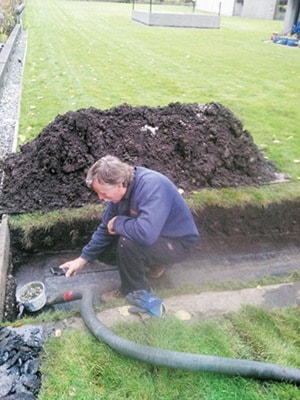While knowing you have a moisture problem may be the first step in resolving the issue, learning the true source of the moisture is must for any longterm solution.
Many homeowners assume water infiltration stems from blocked drains or drain tiles, for example, notes Bill Okell, with Okell Waterproofing. However, issues with the roof, cladding, foundation or substrate can just as easily draw water into the home.
“I always say there are four distinct areas when you own a home: the roof, outside walls, foundation and drainage,” Okell says. “All of these things are independent of each other, but sometimes an issue with one affect the others.
“Be open to the resolution; don’t assume you know what the solution is.”
That means the first goal is the physical identification of the water and its source.
In Oak Bay, for example, residents will tell Okell they’ve had their home for 30 years, but it’s the first time they’ve seen water. On closer inspection, he finds water has been creeping in for years due to thinner or weakened exterior cladding, for example, or inferior doors or windows.
Had they noticed the signs of moisture earlier, the problem wouldn’t be so invasive, and the fix not so costly.
Okell advises homeowners have a look at their doors and windows, paying close attention to the corners, top and bottom. Is it spongy or soft? If so, that indicates water damage.
A concentration of spider webs in a certain exterior area of the home, also suggests the arachnid hunters are staked out to catch ants and termites coming and going through a moisture-damaged area. “It’s a buffet,” Okell says.
Other clues include discolouration of the paint or siding, and continued wetness, even in the sun.
Because older homes in Oak Bay may have many layers of paint, a professional moisture reading may be the only way to determine the extent of the moisture.
While many older Oak Bay homes are well-built to withstand moisture from the sides, basements can be another story.
Homes built over exposed rock, for example, can experience damp, musty odours coming through fissures in the rock, with no actual moisture infiltrating the house, Okell notes. In that case, it’s a matter of putting a coating over the rock to contain the smell.
Other times basements were never meant as liveable space, but rather as coal storage. That means pre-1950s basement floors built from poorer-quality concrete than we have today, and with no rebar or vapour barrier, may need to be re-poured to today’s standards before the basement can be properly finished, Okell says.
“It looks like there’s a drainage issue but often it’s the poor quality of the concrete.”
Some more recently built single-family homes are having similar issues to the “leaky condos” of the late 1980s to mid-1990s, with water infiltrating the walls. “They were built at the same time, but as smaller versions, it just took twice as long as the condos (to show the leaking).”
